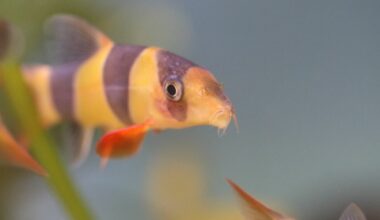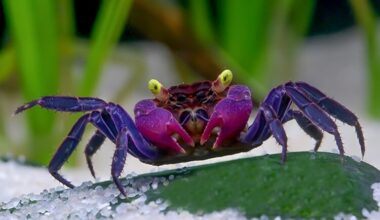If you have or are looking to get a Neon Goby and need additional information, then you are the right place! These tiny, colorful fish are a delight to watch and make a fantastic addition to any aquarium. If you’re looking to add a pop of vibrancy and a touch of elegance to your underwater paradise, then you’ve come to the right place.
In this care guide, we’ll explore the essentials of keeping neon gobies happy and healthy, without getting lost in complicated jargon or overwhelming technical details. Whether you’re a seasoned fish enthusiast or just starting your aquatic journey, caring for neon gobies is a breeze.
So, let’s dive in and discover the secrets to creating a thriving environment for these delightful little creatures, ensuring they flourish and become the stars of your aquatic world!
Table of Contents
Species Summary
The Neon Goby’s scientific name is Elacatinus oceanops and there are 24 recognized species in its genus, which is known as Elacatinus.
Author Note: Some people refer to this fish as the Blue Neon Goby mostly because it is a Neon Goby and well, it has some blue colors but this can be confusing and even wrong. There is actually a Blue Neon Goby called the Electric Blue Neon Dwarf Goby with a scientific name of Stiphodon atropurpureus, and this is a rare freshwater goby since the majority are saltwater fish (usually the ones from Asia are freshwater).
The place of origin for these little fish is the Caribbean. They can be found in the Western Central Atlantic, with areas ranging from South Florida to Texas to Belize. However, most Neon Gobies available for purchase are captive-bred.
Neon Gobies are peaceful fish and easy to maintain. In addition, they are bottom dwellers and enjoy cleaning their surrounding areas and even their tank mates.
Appearance
The Neon Goby is a thin, long-bodied fish with vibrant colors and clear fins. These beautiful fish have two blue horizontal stripes and three black horizontal stripes. Beneath the lower black stripes is silver-to-white coloring. A pinkish hue is found near the gills, making this fish a colorful addition to any aquarium.
Author Note: You may find the Neon Goby’s color to be similar to the Broadstripe Goby and Sharknose Goby, and their body is similar to the Yellowline Goby. If Neon and Yellowline Gobies are bred together, the result is gobies with a yellow to blue stripe.

Lifespan
With proper care, the lifespan of your Neon Goby can be anywhere from five to 10 years. An interesting fact is that in the wild, these gobies only live about two years.
Average Size
The Neon Gobby is a small fish with an average purchase size of 1 to 1.2 inches. It only grows up to 2 or 3 inches as an adult. Males are usually bigger than females, while females display a larger belly when spawning.
When you pair the small size with its thin body, you have one of the best fish to add to a smaller aquarium.
Neon Goby Care
It is easy to care for Neon Goby, which is why many consider it a great starter fish for most aquariums. They adapt quickly to their surroundings and are ready to get right to cleaning.
While Neon Gobies are not as fussy with aspects such as lighting and tank mates, it is still vital to follow certain guidelines for maintaining these small fish.
Tank Size
A 10-gallon tank is the recommended size for a single or pair of Neon Goby. For a school of six or eight of them, you want to increase to a 20 or 30-gallon tank.
Author Note: If you want to add plants and hiding places for gobies, be sure to consider these items when choosing the size of your tank.
Water Parameters
It is essential to create the right environment if you want your fish to thrive and survive. Remember, proper care while in captivity can result in a lifespan of up to 10 years.
Neon Gobies need reef aquarium water parameters, which is a mixture of freshwater and reef salt mix. Luckily, there are many sources with instructions for mixing these components.
Meanwhile, it is important to ensure the rest of the water parameters are meeting your Neon Goby’s needs.
Water temperature: 72 to 78 degrees Fahrenheit (22 to 26 degrees Celsius).
pH levels: 8.1-8.4.
Water hardness: 8-12 dgH.
Specific gravity: 1.023-1.026 SG.
Tank Setup
One of the most important elements to add to their tank is hiding spaces. Of course, you need to locate your little fish before placing plants, rocks and other decor inside their aquarium. Additionally, you want to add lighting and filters to their tank to create the right environment.
Lighting
The Neon Goby does not have any specific lighting requirements, allowing you to choose from a variety of lighting options for your aquarium.
Neon Gobies do prefer dark spaces around their tank, which you can achieve with aquatic plants.
Author Note: Keep in mind that aquatic plants need a certain amount of lighting to grow and survive.
Filtration
Clean water is essential for Neon Gobies, so you need a high-quality aquarium filtration system. One idea is to hang powerhead filters on the back of the aquarium to provide great filtration and water flow. We all thrive best in our natural habitats, and Neon Gobies are no exception.
Acclimation
Many Neon Gobies have been tank raised, so they have already adapted to life in captivity. If you need to acclimate a new Neon Goby, you can rest assured they can easily adapt to their surroundings.
After acclimation, some people introduce their Neon Gobies by placing them in the tank near a hiding spot. Before you know it, your Neon Goby will be doing its job of cleaning its surroundings.
Are Neon Gobies Reef-Safe?
Yes, Neon Gobies are reef-safe! While they do enjoy algae, these small fish do not bother or eat the corals in your tank.
Common Possible Diseases & Prevention
While Neon Gobies are resilient little fish, lack of proper care can cause them to become infected with diseases. Low water quality can lead to typical marine illnesses or stress that impacts their immune system.
Crypt Parasite. Your fish may become infected with Crypt by eating sand, free swimming or being placed in an infected tank. To prevent the crypt parasite from completing its cycle, raise the water temperature to 82 degrees Fahrenheit or 28 degrees Celsius.
Author Note: Neon Gobies can actually eat the Crypt while the parasite is still close to the surface of the skin. In fact, doing so can help relieve their symptoms during a Crypt outbreak and you still need to raise the temperature of the water.
Food & Diet
The diet of the Neon Goby is carnivorous, and they can get by on eating meaty foods such as shrimp, fish and worms. Additionally, live copepods found in the sand can supplement their diet.
Otherwise, these fish enjoy algae, scales, parasites and fish slime. You can also feed your Neon Goby flakes, tablets or pellets with the main food of shrimp. However, these types of food should not be their main diet.
In addition, you want to feed them several times per day.
Behavior & Temperament
Neon Gobies are peaceful and can co-exist with other species of fish. The interesting part is how other fish know it is the Neon Goby’s job to clean them.
When another fish sees a Neon Goby, it may position itself sideways or with its head down. This lets the Neon Goby know it wants to be cleaned.
Author Note: Neon Gobies clean parasites and dead scales off other fish, which is why even larger species do not eat them unless it is accidental.

Neon Goby Tank Mates
These fish do well alone or in male and female pairs. When housing a school of fish, it is best to stick with a group of six or eight to keep pairs from hunting down additional gobies. In groups of six or eight, Neon Gobies can co-exist with only a few squabbles between the males.
As for other fish, the following species make great tank mates for Neon Gobies.
- Firefish Goby
- Clownfish like the Ocellaris Clownfish
- Yellow Tang
- Hippo Tang
Breeding
If you were to rate the ease of breeding on a scale, you may find it moderate to breed Neon Gobies. It is not always easy to determine the sex of the fish, but some people purchase many Neon Gobies and let them pair on their own.
Then again, you may be able to tell the difference with a good eye. The females’ genital papilla are rounded, while the males’ genital papilla are pointed.
Once your Neon Gobies pair up, you can start preparing a breeding tank. It is not uncommon for some Neon Gobies to become aggressive while breeding, so you want to use a 20-gallon tank with plenty of space and several hiding spots.
Author Note: When adjusting the breeding temperature in the tank, it is recommended to raise the temperature by 2 degrees to increase the pair’s breeding activity.
Spawning gobies prefer to lay their eggs in a small cave or crevice. It takes eggs about six to eight days to hatch in temperatures between 75 degrees Fahrenheit and 81 degrees Fahrenheit. You want to keep transferred eggs or larvae in a 20-gallon tank with recurring water changes.
In an interesting twist, the male protects and aerates the eggs, while the female only visits the site occasionally. While she does not interact with the eggs, the parents may become aggressive while defending their eggs and nest.
Moreover, Neon Gobies also interbreed with other fish from their genus, such as the Yellowlined Goby.
Wrapping Up
There you have it, you are now ready to care for your Neon Goby! With their peaceful nature and unique cleaning abilities, they make wonderful additions to both beginner and experienced fishkeepers’ tanks.
Remember, providing a well-maintained and appropriately sized aquarium, along with a balanced diet, is crucial for the overall health and happiness of your neon goby. By following this care guide and offering enough care and attention, you’ll be able to witness the vibrant beauty of these captivating neon gobies for years to come.
Best of luck and please do not hesitate to reach out to us with any questions, maybe even tag us on Facebook with a nice photo of your aquarium 😉

